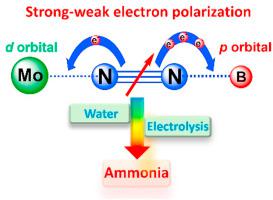Nano Energy ( IF 17.6 ) Pub Date : 2020-09-18 , DOI: 10.1016/j.nanoen.2020.105391 Yaxiao Guo , Zhaoyang Yao , Shaoqi Zhan , Brian J.J. Timmer , Cheuk-Wai Tai , Xiyu Li , Zhen Xie , Qijun Meng , Lizhou Fan , Fuguo Zhang , Mårten S.G. Ahlquist , Maria Cuartero , Gaston A. Crespo , Licheng Sun

|
Ammonia production consumes ∼2% of the annual worldwide energy supply, therefore strategic alternatives for the energy-intensive ammonia synthesis through the Haber-Bosch process are of great importance to reduce our carbon footprint. Inspired by MoFe-nitrogenase and the energy-efficient and industrially feasible electrocatalytic synthesis of ammonia, we herein establish a catalytic electrode for artificial nitrogen fixation, featuring a carbon fiber cloth fully grafted by boron-doped molybdenum disulfide (B-MoS2/CFC) nanosheets. An excellent ammonia production rate of 44.09 μg h–1 cm–2 is obtained at −0.2 V versus the reversible hydrogen electrode (RHE), whilst maintaining one of the best reported Faradaic efficiency (FE) of 21.72% in acidic aqueous electrolyte (0.1 M HCl). Further applying a more negative potential of −0.25 V renders the best ammonia production rate of 50.51 μg h–1 cm–2. A strong-weak electron polarization (SWEP) pair from the different electron accepting and back-donating capacities of boron and molybdenum (2p shell for boron and 5d shell for molybdenum) is proposed to facilitate greatly the adsorption of non-polar dinitrogen gas via N≡N bond polarization and the first protonation with large driving force. In addition, for the first time a visible light driven photo-electrochemical (PEC) cell for overall production of ammonia, hydrogen and oxygen from water + nitrogen, is demonstrated by coupling a bismuth vanadate BiVO4 photo-anode with the B-MoS2/CFC catalytic cathode.
中文翻译:

钼和硼协同促进高效的电化学固氮
氨的生产消耗了全世界每年约2%的能源,因此通过哈伯-博世(Haber-Bosch)工艺合成高能耗氨的战略替代方案对于减少我们的碳足迹非常重要。受MoFe固氮酶和高效节能且工业上可行的氨的电催化合成的启发,我们在此建立了一种用于人工固氮的催化电极,其特征在于碳纤维布完全由掺硼的二硫化钼(B-MoS 2 / CFC)接枝。纳米片。出色的氨生产速率为44.09μgh –1 cm –2相对于可逆氢电极(RHE)在-0.2 V时获得的H2O2,同时在酸性含水电解质(0.1 M HCl)中仍保持着21.72%的最佳法拉第效率(FE)之一。进一步施加-0.25 V的负电势可使氨的最佳生产率达到50.51μgh –1 cm –2。提出了一种由硼和钼的不同电子接受能力和背向供体能力构成的强弱电子极化对(SWEP)(硼为2 p壳,钼为5 d壳),以极大地促进非极性二氮气体的吸附通过N≡N键极化和第一质子化具有很大的驱动力。此外,首次通过将钒酸铋BiVO 4光阳极与B-MoS 2耦合,展示了一种可见光驱动的光电化学(PEC)电池,用于从水和氮中整体生产氨,氢和氧。/ CFC催化阴极。



























 京公网安备 11010802027423号
京公网安备 11010802027423号